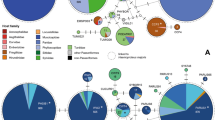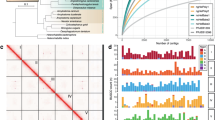Abstract
Little is known about the Hox gene complement in parasitic platyhelminthes (Neodermata). With the aim of identifying Hox genes in this group we performed two independent strategies: we performed a PCR survey with degenerate primers directed to the Hox homeobox in the cestode Mesocestoides corti, and we searched genomic assemblies of Echinococcus multilocularis and Schistosoma mansoni. We identified two Hox genes in M. corti, seven in E. multilocularis, and nine in S. mansoni (including five previously reported). The affinities of these sequences, and other previously reported Hox sequences from flatworms, were determined according to phylogenetic analysis, presence of characteristic parapeptide sequences, and unusual intron positions. Our results suggest that the last common ancestor of triclads and neodermatans had a Hox gene complement of at least seven genes, and that this was probably derived by gene loss from a larger ancestral Hox complement in lophotrochozoans.





Similar content being viewed by others
References
Aguinaldo AM, Turbeville JM, Linford LS, Rivera MC, Garey JR, Raff RA, Lake JA (1997) Evidence for a clade of nematodes, arthropods and other moulting animals. Nature 387:489–493
Ax P (1996) Multicellular animals—a new approach to the phylogenetic order in nature—vol I. Springer Verlag, Berlin
Balavoine G (1997) The early emergence of platyhelminths is contradicted by the agreement between 18S rRNA and Hox genes data. C R Acad Sci III 320:83–94
Balavoine G, Telford MJ (1995) Identification of planarian homeobox sequences indicates the antiquity of most Hox/homeotic gene subclasses. Proc Natl Acad Sci USA 92:7227–7231
Balavoine G, de Rosa R, Adoutte A (2002) Hox clusters and bilaterian phylogeny. Mol Phylogenet Evol 24:366–373
Bartels JL, Murtha MT, Ruddle FH (1993) Multiple Hox/HOM-class homeoboxes in Platyhelminthes. Mol Phylogenet Evol 2:143–151
Bayascas JR, Castillo E, Munoz-Marmol AM, Salo E (1997) Planarian Hox genes: novel patterns of expression during regeneration. Development 124:141–148
Britos L, Dominguez L, Ehrlich R, Marin M (2000) Effect of praziquantel on the strobilar development of Mesocestoides corti in vitro. J Helminthol 74:295–299
Bürglin T (1994) A comprehensive classification of homeobox genes. In: Duboule D (ed) Guidebook to the homeobox genes. Oxford University Press, Oxford
Chourrout D, Delsuc F, Chourrout P, Edvardsen RB, Rentzsch F, Renfer E, Jensen MF, Zhu B, de Jong P, Steele RE, Technau U (2006) Minimal ProtoHox cluster inferred from bilaterian and cnidarian Hox complements. Nature 442:684–687
de Rosa R, Grenier JK, Andreeva T, Cook CE, Adoutte A, Akam M, Carroll SB, Balavoine G (1999) Hox genes in brachiopods and priapulids and protostome evolution. Nature 399:772–776
Ferrier D (2007) Evolution of Hox gene cluster. In: Papageorgiou S (ed) HOX gene expression. Springer Science + Business Media, New York
Ferrier DE, Holland PW (2001) Sipunculan Parahox genes. Evol Dev 3:263–270
Garcia-Fernàndez J (2005) Hox, Parahox, ProtoHox: facts and guesses. Heredity 94:145–152
Gehring W (2007) The homeobox as a key for understanding the principles of the genetic control of development. In: Papageorgiou S (ed) HOX gene expression. Springer Science + Bussiness Media, New York
Hall TA (1999) BioEdit: a user-friendly biological sequence alignment editor and analysis program for Windows 95/98/NT. Nucl Acids Symp Ser 41:95–98
Helmkampf M, Bruchhaus I, Hausdorf B (2008) Multigene analysis of lophophorate and chaetognath phylogenetic relationships. Mol Phylogenet Evol 46:206–214
Iglesias M, Gomez-Skarmeta JL, Saló E, Adell T (2008) Silencing of Smed-betacatenin1 generates radial-like hypercephalized planarians. Development 135:1215–1221
Kim KH, Lee YS, Jeon HK, Park JK, Kim CB, Eom KS (2007) Hox genes from the tapeworm Taenia asiatica (Platyhelminthes: Cestoda). Biochem Genet 45:335–343
Kulakova M, Bakalenko N, Novikova E, Cook CE, Eliseeva E, Steinmetz PR, Kostyuchenko RP, Dondua A, Arendt D, Akam M, Andreeva T (2007) Hox gene expression in larval development of the polychaetes Nereis virens and Platynereis dumerilii (Annelida, Lophotrochozoa). Dev Genes Evol 217:39–54
Kulakova MA, Cook CE, Andreeva TF (2008) Parahox gene expression in larval and postlarval development of the polychaete Nereis virens (Annelida, Lophotrochozoa). BMC Dev Biol 8:61
Kumar S, Tamura K, Nei M (2004) MEGA3: Integrated software for molecular evolutionary genetics analysis and sequence alignment. Brief Bioinform 5:150–163
Larroux C, Fahey B, Degnan SM, Adamski M, Rokhsar DS, Degnan BM (2007) The NK homeobox gene cluster predates the origin of Hox genes. Curr Biol 17:706–710
Lartillot N, Philippe H (2008) Improvement of molecular phylogenetic inference and the phylogeny of Bilateria. Philos Trans R Soc Lond B Biol Sci 363:1463–1472
McManus DP, Knight M, Simpson AJ (1985) Isolation and characterisation of nucleic acids from the hydatid organisms, Echinococcus spp. (Cestoda). Mol Biochem Parasitol 16:251–266
Minguillón C, Garcia-Fernàndez J (2003) Genesis and evolution of the Evx and Mox genes and the extended Hox and Parahox gene clusters. Genome Biol 4:R12
Nielsen C (2001) Animal evolution: interrelationships of the living phyla. Oxford University Press, Oxford
Nogi T, Watanabe K (2001) Position-specific and non-colinear expression of the planarian posterior (Abdominal-B-like) gene. Dev Growth Differ 43:177–184
Ogishima S, Tanaka H (2007) Missing link in the evolution of Hox clusters. Gene 387:21–30
Olson PD (2008) Hox genes and the parasitic flatworms: new opportunities, challenges and lessons from the free-living. Parasitol Int 57:8–17
Orii H, Kato K, Umesono Y, Sakurai T, Agata K, Watanabe K (1999) The planarian HOM/HOX homeobox genes (Plox) expressed along the anteroposterior axis. Dev Biol 210:456–468
Pierce RJ, Wu W, Hirai H, Ivens A, Murphy LD, Noel C, Johnston DA, Artiguenave F, Adams M, Cornette J, Viscogliosi E, Capron M, Balavoine G (2005) Evidence for a dispersed Hox gene cluster in the platyhelminth parasite Schistosoma mansoni. Mol Biol Evol 22:2491–2503
Saló E, Tauler J, Jimenez E, Bayascas JR, Gonzalez J, Garcia Fernandez J, Baguña J (2001) Hox and parahox genes in flatworms: characterization and expression. Amer Zool 41:652–663
Sambrook J, Fritsch E, Maniatis T (1989) Molecular cloning: a laboratory manual. Cold Spring Harbor Laboratory, Cold Spring Harbor, New York
Tarabykin VS, Lukyanov KA, Potapov VK, Lukyanov SA (1995) Detection of planarian Antennapedia-like homeobox genes expressed during regeneration. Gene 158:197–202
Telford MJ (2000a) Turning Hox “signatures” into synapomorphies. Evol Dev 2:360–364
Telford MJ (2000b) Evidence for the derivation of the Drosophila fushi tarazu gene from a Hox gene orthologous to lophotrochozoan Lox5. Curr Biol 10:349–352
Thompson JD, Higgins DG, Gibson TJ (1994) CLUSTAL W: improving the sensitivity of progressive multiple sequence alignment through sequence weighting, position-specific gap penalties and weight matrix choice. Nucleic Acids Res 22:4673–4680
Webster PJ, Mansour TE (1992) Conserved classes of homeodomains in Schistosoma mansoni, an early bilateral metazoan. Mech Dev 38:25–32
Acknowledgments
The authors thank Laura Dominguez and Jenny Saldaña for providing infected mice, and Madelón Portela for technical assistance and the Automatic Sequencing of the Faculty of Sciences. We are very grateful to the Echinococcus multilocularis and Schistosoma mansoni Sequencing Groups at the Sanger Institute for permitting us to work with the genomic assemblies, and to Najib M. El-Sayed (University of Maryland), and Klaus Brehm (Universität Würzburg). This work was supported by IFS, DINACYT, and a M.Sc. fellowship from PEDECIBA to A.I.L.
Author information
Authors and Affiliations
Corresponding author
Rights and permissions
About this article
Cite this article
Koziol, U., Lalanne, A.I. & Castillo, E. Hox Genes in the Parasitic Platyhelminthes Mesocestoides corti, Echinococcus multilocularis, and Schistosoma mansoni: Evidence for a Reduced Hox Complement. Biochem Genet 47, 100–116 (2009). https://doi.org/10.1007/s10528-008-9210-6
Received:
Accepted:
Published:
Issue Date:
DOI: https://doi.org/10.1007/s10528-008-9210-6




